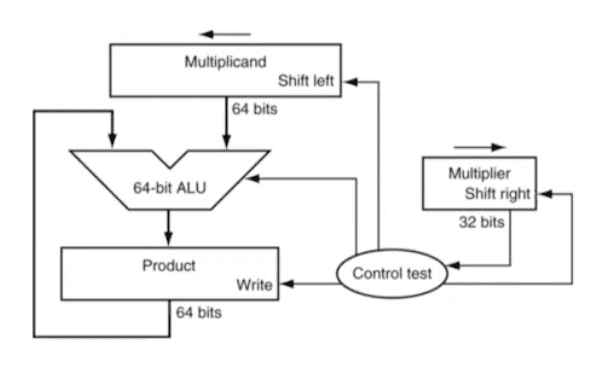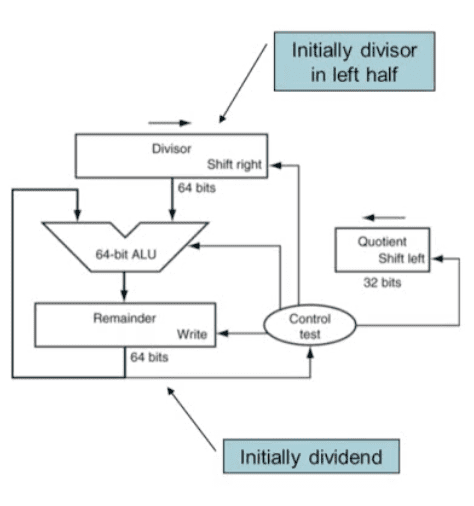[컴퓨터구조론] 3. Arithmetic for Computers
2020-09-14
본 글은 영남대학교 최규상 교수님의 컴퓨터 구조 강의를 듣고 작성된 글입니다.
3.1 Introduction
3.2 Addition and Subtraction
-
Integer Addition
-
Overflow if result out of range
- Adding +ve and -ve operands, no overflow
-
Adding two +ve operands
- Overflow if result sign is 1
- Adding tow -ve operands -Overflow if result sign is 0
-
-
Integer Subtraction
- Add negation of second operand
-
Overflow is result out of range
- Subtracting two +ve or two -ve operands, no overflow
-
Subtracting +ve from -ve operand
- Overflow if result sign is 0
-
Subtracting -ve from +ve operand
- Overflow if result sign is 1
-
Dealing with Overflow
-
Some languages(e.g., C) ignore overflow
- Use MIPS addu, addui, subu instructions
- Other languages(e.g., Ada, Fortran) require raising an exception
-
-
Arithmetic for Multimedia
-
Graphics and media processing operates on vectors of 8-bit and 16-bit data
-
Use 64-bit adder, with partitioned carry chain
- Operate on 8*8-bit, 4*16-bit, or 2*32-bit vectors
- SIMD (single-instruction, multiple-data)
-
-
Saturating operations
- On overflow, result is larges representable value
- E.g., clipping in audio, saturation in video
-
3.3 Multiplication
3.4 Division
3.5 Floating Point
-
Representation for non-integral numbers
- Including very small and very large numbers
-
Like scientific notation
-
normalized
- -2.34 * 10^56
-
not normalized
- +0.002 * 10^-4
- +987.02 * 10^9
-
-
In binary
- +-1.xxxxx * 2^n
- Types float and double in C
-
Floating Point Standard
- Defined by IEEE Std 754-1985
-
Developed in response to divergence of representations
- Portability issues for scientific code
- Now almost universally adopted
-
Two representations
-
Single precision (32-bit)
- sign: 1 bit
- exponent: 8 bit
- fraction: 23 bit
-
Double precision (64-bit)
- sign: 1bit
- exponent: 11 bit
- fraction: 52 bit
-
-
IEEE Floating-Point Format
x = (-1)^S * (1 + Fraction) * 2^(Exponent - Bias)-
S: sign bit
- 0: non-negative
- 1: negative
-
Normalize significand: 1.0 <= |significand| < 2.0
- Always has a leading pre-binary-point 1 bit, so no need to represent if explicitly (hidden bit)
- Significand is Fraction with the "1." restored
-
Exponent: excess representation: actual exponent + Bias
- Ensures exponent is unsigned
- Single: Bias = 127; Double: Bias = 1203
-
Infinities and NaNs
-
Exponent = 111...1, Fraction = 000...0
- +-Infinity
- Can be used in subsequent calculations, avoiding need for overflow check
-
Exponent = 111...1, Fraction != 000...0
- Not-a-Number (NaN)
-
-
Floating-Point Addition
- Align binary points
- Add significands
- Normalize result & check for over/underflow
- Round and renormalize if necessary
-
Floating-Point Adder Hardware
- Much more complex than integer adder
-
Doing it in one clock cycle would take too long
- Much longer than integer operations
- Slower clock would penalize all instructions
-
FP adder usually takes several cycles
- Can be pipelined
-
Floating-Point Multiplication
- Add exponents
- Multiply significands
- Normalize result & check for over/underflow
- Round and renormailze if necessary
- Determine sign
-
Floating-Point Arithmetic Hardware
- FP multiplier is of similar complexity to FP adder
-
FP arithmetic hardware usually does
- Addition, subtraction, multiplication division, reciprocal, square-root
- FP <-> integer conversion
-
FP adder usually takes several cycles
- Can be pipelined

